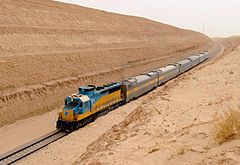- Dammam–Riyadh Line
-
The Dammam–Riyadh Line, also called Line 1, connects the cities of Dammam, Abqaiq, Hofuf and Riyadh (449.11 km) and is used by passenger trains. It is a very picturesque route, that takes you through the desert dunes, connecting the central region to the Persian Gulf. The total journey takes about 4.5 hours and during that time, TV and snacks are offered on board.
Contents
Stations
There are four stations along the route:
- Dammam Railway Station (location: 0.000), terminus.
- Abqaiq Railway Station (location: 74.000)
- Hofuf Railway Station (location: 139.257)
- Riyadh Railway Station (location: 449.086), terminus.
The current passenger stations at Dammam, Hufuf and Riyadh were designed by Lucio Barbera and designed and built between 1978 and 1980. They were opened for public service in 1981. The terminus stations in Dammam and Riyadh are extremely similar and consist of a rectangular hall of three naves separated by two lines of pillars along the ends of the tracks and two wings at the ends of the main hall along the outer tracks. The design is based on the layout of some mosques along the Mediterranean Sea, where the prayer hall is located at one side of a court with lesser wings along the sides of the court.[1] The style and decoration of the buildings uses elements such as triangular openings to construct windows and arcades and parapets with rectangular steps.[2] This somewhat reminds of Nejd architecture but is also common in other Arab architecture. The station building in Hufuf lays to the east of the through line along one side. The decoration is very similar to the other two stations though.
Technology
Rail
Rails of the type C.W.R UIC 60 are used.[3]
Signaling System
In 2007, the Saudi Railways Organization (SRO) contracted a consortium made up of Siemens Transportation Systems and the Saudi Arabian Nour Communications Company to modernize both Line 1 and Line 2 of the existing Saudi Rail network. The line will be equipped with signalling technology including an electronic interlocking as core of the installation and Trainguard 100 for ETCS Level 1. GSM-Railway (GSM-R) mobile radio technology will be used for communications on the entire rail network.[4]
References
- ^ A short description of the Dammam station at ArchNet.org with a comparison of the station plan to the layout of the Al-Ashar mosque in Cairo and other pictures.
- ^ On this page at the website of Lucio Barbera, click on the year 82 of the "Integrated Projects" time line to see a plan some drawings and pictures.
- ^ Saudi Railways Organization. "Technical Information". Archived from the original on 2008-04-11. http://web.archive.org/web/20080411140540/http://www.saudirailways.org/english/technical_information.htm. Retrieved 2008-07-09.
- ^ Siemens AG. "Dammam - Riad, Saudi Arabia". http://references.transportation.siemens.com/refdb/showReference.do?r=2095&div=2&div=2&div=2&div=2&div=2&l=en. Retrieved 2008-07-09.
Rail transport in Asia Sovereign
states- Afghanistan
- Armenia
- Azerbaijan
- Bahrain
- Bangladesh
- Bhutan
- Brunei
- Burma (Myanmar)
- Cambodia
- People's Republic of China
- Cyprus
- East Timor (Timor-Leste)
- Egypt
- Georgia
- India
- Indonesia
- Iran
- Iraq
- Israel
- Japan
- Jordan
- Kazakhstan
- North Korea
- South Korea
- Kuwait
- Kyrgyzstan
- Laos
- Lebanon
- Malaysia
- Maldives
- Mongolia
- Nepal
- Oman
- Pakistan
- Philippines
- Qatar
- Russia
- Saudi Arabia
- Singapore
- Sri Lanka
- Syria
- Tajikistan
- Thailand
- Turkey
- Turkmenistan
- United Arab Emirates
- Uzbekistan
- Vietnam
- Yemen
States with limited
recognition- Abkhazia
- Nagorno-Karabakh
- Northern Cyprus
- Palestine
- Republic of China (Taiwan)
- South Ossetia
Dependencies and
other territories- Christmas Island
- Cocos (Keeling) Islands
- Hong Kong
- Macau

This article about transport in Saudi Arabia is a stub. You can help Wikipedia by expanding it.

